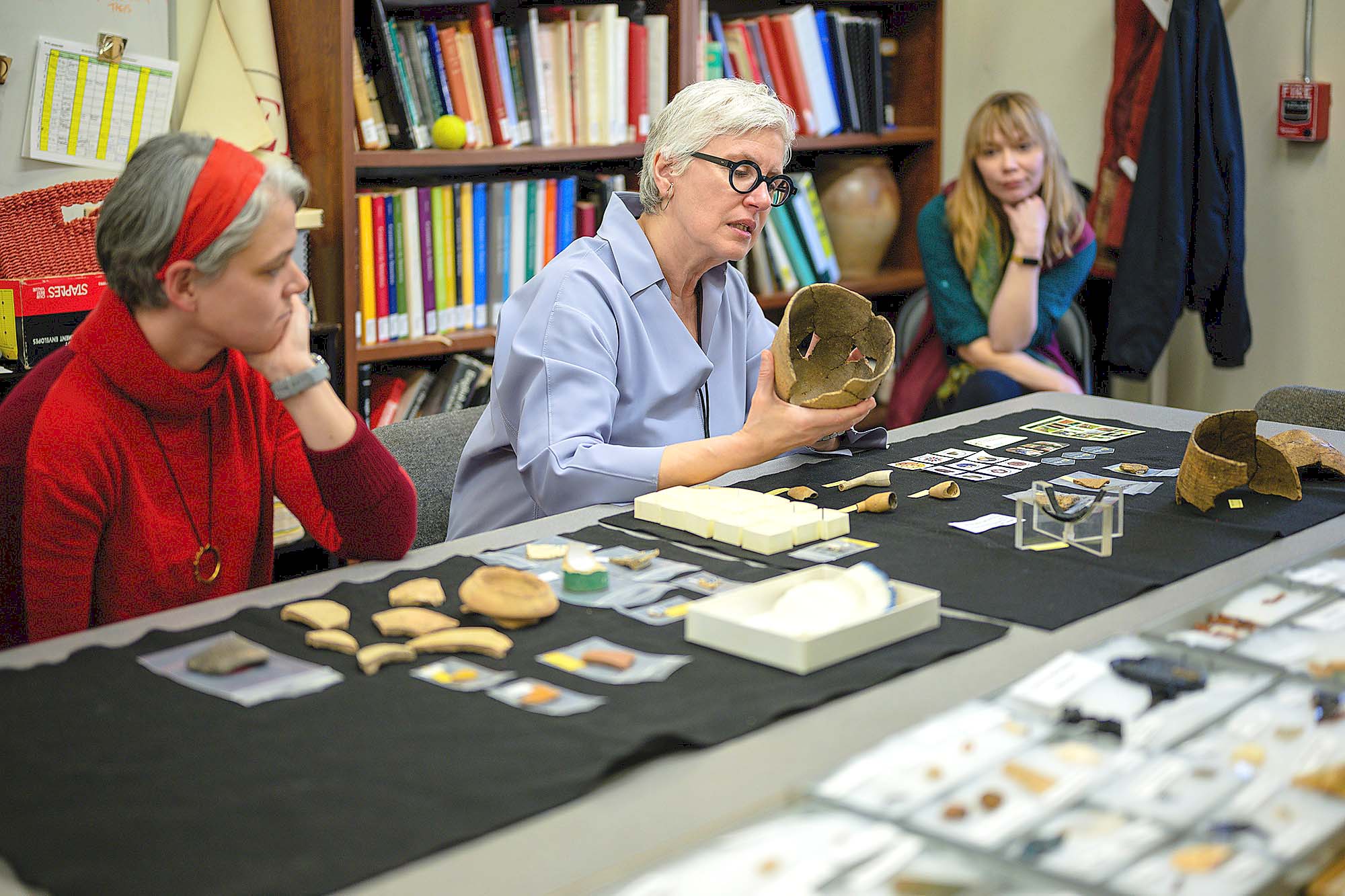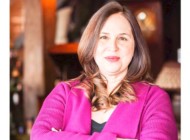
©Thomas Jefferson Foundation at Monticello.
As the home of the author of the Declaration of Independence and in its own right a World Heritage Site, historic house and plantation, museum, research institute, presidential library and private nonprofit organization, Monticello will be familiar to most if not all readers. In October 2023, Monticello announced it had appointed historian Jane Kamensky as its new president. The long-time academic is considered by some to be a dynamic appointment, not only for Monticello but for the museum community, so Antiques and The Arts Weekly leapt at the chance to speak to her. Despite a rigorous schedule following her mid-January start, she was kind enough to share her reasons for the move and what her immediate and long-term priorities for the institution were.
You come to Monticello from an academic background, most recently as a Harvard history professor and the Carl and Lily Pforzheimer Foundation director of the Arthur and Elizabeth Schlesinger Library on the History of Women in America at the Radcliffe Institute, after a two-decade tenure at Brandeis University, and a stint at Brown University. What was the allure of Monticello that drew you away from academia?
I had a very fortunate career in higher education and was privileged to teach — and learn from — innumerable bright, committed young people. In my classroom, especially when teaching the history of the American Revolution, I encountered a hunger for civic engagement among my students, many of whom did site-based capstone projects for the course. I came to Monticello because I, too, feel that hunger: for public-facing history that probes our past and connects our foundations to our present and future. The nation’s semi-quincentennial, in 2026, offers an ideal moment to feed that yearning. Monticello welcomes hundreds of thousands of guests each year to this beautiful mountaintop. We can help to set the national table, for a Jeffersonian “feast of reason” as we explore complex history with a passionate — and divided — public.

Monticello ©Thomas Jefferson Foundation at Monticello.
As you’ve settled in, can you describe your transition from an academic to the hands-on administrator of a well-known historic site?
Monticello is a research-driven institution. Our staff is filled with scholars who study history, architecture, art and material culture, horticulture, descendant community engagement, the science of interpretation and much more. In many ways, these avenues of our work resemble university departments, with world-class professionals engaged in the work of discovery. But here, much of that work has clear and pressing application: to serve our diverse visitors. To put this succinctly: I’m still in the archive — Monticello is an archive. But now I have a much more immediate sense of the audience. Glimpsing hundreds of guests through my office windows each day, talking to visitors on the bus and learning from our guides about the questions people bring to their tours helps focus the mind!
What’s been your primary agenda for your first few months at Monticello?
In many ways, I’ve gone back to school. We employ some 380 people, and several dozen more volunteer their time. I’ve focused on learning the art and science of what our folks do, where they do it and what they need to do it even better. That means seeing Jefferson’s house through the lens of curation and restoration. It means walking the landscape — we preserve nearly 3,000 of Jefferson’s 5,000 acres — with archaeologists, historians and members of the descendant community. It means meeting with our teams of scholars and taking stock of their successes as we devise future priorities. Together with our staff, we’re engaging key stakeholders around the region and the country as we anticipate what’s possible for 2026 and beyond.

One recent project includes documenting and repairing the highly detailed composition ornaments found throughout the house. Kamensky is shown here with Lucy Midlefort, architectural conservator, and Carol Richardson, senior restoration specialist. ©Thomas Jefferson Foundation at Monticello.
It’s no secret that Monticello and Jefferson played a role in the history of slavery in the United States, and recent endeavors — an exhibition on Sally Hemings, rebuilding a slave cabin and workshops where enslaved people labored and hosting reunions for Jefferson’s Black descendants — have been an attempt to talk more openly about the issue. What has been the reception to these and is the conversation still ongoing?
Monticello was at once a laboratory for Jefferson’s world-historical experiment in self-government and a plantation that enslaved more than a hundred men, women and children at any given time. For more than 30 years, Monticello has undertaken the work of publicly interpreting what a landmark exhibition here called “the paradox of liberty.” We were one of the first public history sites in the United States to embrace that complexity, to interpret it for our visitors, and to help chart a course for our peers as well. Monticello is a place that does hard things well, at a time when so many institutions in American life do easy things badly.
The conversation around slavery is important, ongoing and indeed expanding; recently, the Mellon Foundation awarded our Getting Word African American Oral History Project a four-year grant of $3.5 million. The grant, made under the auspices of the foundation’s Monuments Project, has allowed Getting Word director Andrew Davenport to expand his team to collect more oral histories, to further engage the descendant community, and to create a digital archive of slavery at Monticello that will make more of our documentation freely accessible around the world.
Because of the soaring promise of Jefferson’s Declaration, the paradox of slavery and liberty in our founding crystalizes at Monticello. The engagement of a passionate and variegated descendant community shows that slavery wasn’t the totality of anybody’s story — including Jefferson’s. We’re a profound site of American history, which means we’re a site of Black history, and Black achievement. It stirs me when my colleague Gayle Jessup White, the author of Reclamation and a Hemings descendant, says, with obvious pride, “Welcome to Monticello, my ancestral home.”

Kamensky inspecting a cross-mended Native American pot from Flowerdew Hundred Plantation, a collection from the Williamsburg. To the left is Beth Bollwerk, project manager, Digital Archaeological Archive of Comparative Slavery (DAACS). ©Thomas Jefferson Foundation at Monticello.
Monticello’s story is so much more compelling and complex than just its involvement with slavery. Can you discuss some of the recent or ongoing initiatives?
In our work around the history of slavery as in everything else, Monticello is a place that embraces the both/and of American life. Jefferson’s biography teaches us that patriotism in a republic requires a clear-eyed reckoning with the past.
Guest surveys tell us a lot about what our visitors want more of and Jefferson’s political career looms large. As we plan for 2026, we’re exploring a new tour dedicated to the origins of American partisanship and the ways Jefferson transcended partisan divisions, especially in his long relationship with John Adams.
We’re also focused on access, broadly defined. That means making sure the mountaintop pathways better serve all visitors. It means expanding our onsite and virtual programs for educators and students. And it means hitting the road, as we take our content and approach into the community and around the country.
As a historian, are there avenues of research at Monticello that haven’t been fully tapped that you’d like to see pursued, or that staff there are proposing?
My colleagues and I are thinking a lot about how to better integrate the various strands of our research enterprise, which include a vibrant fellowship program, ongoing discoveries in Monticello collections of art and artifacts, the Getting Word oral history enterprise, to our pace-setting strength in the academic discipline of public history interpretation and much more. There are so many avenues of curiosity-driven work here, and so many different kinds of discovery. Connecting them to each other, and to the experience of our visitors, is a priority across the foundation.

Kamensky walking with historic interpreter, Bill Barker. ©Thomas Jefferson Foundation at Monticello.
In 2026, will Monticello celebrate the 250th anniversary of the Declaration of Independence? Can you share some details of what plans are afoot?
We mark two major anniversaries in 2026: the 250th anniversary of Jefferson’s Declaration, and the 200th anniversary of his death exactly 50 years later, on July 4, 1826. We’re refreshing our Declaration gallery and thinking a lot about the world the Declaration set in motion. And we’re partnering with other presidential sites, museums and civil society organizations, as well as with the state and national 250th commissions, to get the word out.
My fondest hope for 2026 is that Monticello will serve as a beacon to guide the ongoing journey of American constitutional democracy, by sharing the history of Jefferson and all who lived and labored in this place, and by leveraging Jefferson’s example to teach the skills of civil disagreement that allow us to move forward as one people.
[Editor’s note: For more information on Kamensky and Monticello’s ongoing and planned initiatives, see www.monticello.org/research-education/blog/roundabout-with-jane-kamensky/?utm_source=ET&utm_medium=email&utm_term=&utm_content=janekbut&utm_campaign=jane100]
—Madelia Hickman Ring




